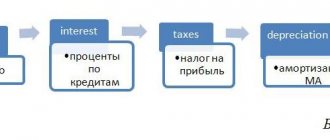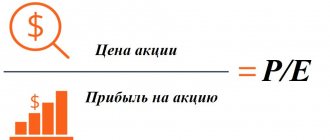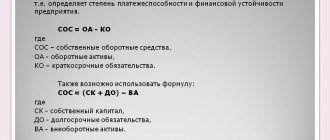What is revenue from product sales?
Revenue from product sales represents cash income received by an organization from customers for products sold. The indicator expresses the monetary relations between producers and consumers of goods. Revenue from sales of products is determined based on the quantity of products sold and their cost. For tax purposes, it is recognized as income from sales.
Revenue is not profit; a separate line is allocated for it in the “Income Statement”. The head of the organization must ensure the uninterrupted flow of revenue, since without this the business simply will not be able to function.
The following factors influence the amount of revenue from product sales:
- internal (production volume, range of manufactured goods, their quality and competitiveness, level of prices applied, cost, compliance with contractual terms, etc.);
- external (violation of contract terms, interruptions in transport, etc.).
How does revenue differ from income, turnover, profit?
Revenue is reflected in the receipt of cash and other property. And provided that goods and services (work) are provided on the basis of a commercial loan, in the form of deferred payment, revenue is accounted for according to the amount of receivables. Methods for reflecting it are defined by law:
- cash, when the actual payment is made to the organization’s account;
- accrual method, when products are shipped, services are provided, or work is performed upon presentation of payment documents.
In the first case, the generation of revenue is associated with the receipt of funds into the account. In the second, it is determined not by payment, but by the date of shipment. An enterprise, based on the characteristics of its business activities and contractual policy, chooses one method to use, but can change it if desired.
The amount of revenue differs from the cost of goods produced and shipped due to the existence of unsold products; sold with a deferment, the money for which has not yet been received; not paid on time; as well as being in the custody of the buyer.
Products and services sold at selling prices generate revenue, which includes three components:
- Profit. Forms financial assets that ensure the development of the enterprise.
- Cost price. Reimburses production costs.
- Taxes. Provide contributions to the budget.
In accounting, revenue is calculated at selling prices with VAT and excise taxes (gross) or without them (net), as well as at prices determined by the plan.
The organization’s revenue, regardless of the type and type of its activity, is recorded in account 90 “Sales”. It accumulates complete information about the income and expenses of the enterprise.
Postings reflect accounting:
- sold products and goods;
- services provided and work performed;
- leased property, etc.
Debit of account 62 “Settlements with buyers and customers” - Credit of account 90 “Sales”, subaccount “Revenue”.
Debit account 50 “Cash” – Credit account 90.
Debit 62 Credit 90-1 – revenue from the sale of finished products, work performed, services provided, including VAT, is recognized.
Debit 62 – Credit 68 “Calculations for VAT” VAT is charged to the budget.
Debit 90-3 – Credit 68 “Calculations for VAT”.
At the same time, based on the invoice, the cost of goods, works, and services sold is written off:
- Debit 90-2 – Credit 20, 26, 43, 41.
- Debit 90-2 – Credit 44 – “Sales expenses”.
The balance sheet does not contain lines to record revenue. But at the same time, it is related to revenue, since it reflects the volume of assets and liabilities of the enterprise, as well as their changes, which can be used to judge the fall or growth of revenue.
Read about how to reflect sales revenue in accounting and which line in the balance sheet shows its amount here.
As they say, revenue and profit are always somewhere nearby. But despite this, they are fundamentally different concepts. The fact is that revenue includes both profit and cost. In order to understand this, let's look at how the unit price is formed.
Price = Cost (Expenses) Trade margin.
The trade margin in this formula is the source of profit. Profit is formed by multiplying the trade margin by the number of products sold.
Profit = Revenue - Cost amount = (Price - Cost) x Number of goods sold.
In this case, the profit formula may also vary depending on the availability of data for calculation. In the simplest case, profit is the difference between revenue and cost. But, if we remember that the cost includes only costs associated with production (raw materials, water supply and electricity for production purposes, wages of production personnel), then you can see that the formula looks slightly unrealistic.
The revenue indicator is the basis of the Profit and Loss Statement of an enterprise, the structure and methods of filling it out have their own characteristics.
The relationship between revenue and income is in many ways similar to the profit example discussed above. Let us note once again that the amount of revenue does not mean that the amount of income will be similar. Thus, income is a more “purified” concept.
Let's look at this with an example.
You produced 100 units of products and then sold them at a price of 50 rubles per unit. Then the revenue amounted to 5,000 rubles. But this does not mean that the income is the same amount.
Firstly, the unit cost of production was 15 rubles per unit. And for the entire sales volume this is 15 x 100 = 1500 rubles.
Secondly, during the sale of products the following types of expenses were also incurred (in total):
- Management costs = 150 rubles;
- Commercial expenses = 350 rubles.
Profit = Revenue - Cost - Selling expenses - Administrative expenses = 5000 - 1500 - 150 - 350 = 3000 rubles.
But, again, a profit of 3,000 rubles does not mean that the profitability of the enterprise was 3,000 rubles. For example, an entrepreneur also had temporarily free funds and decided to invest them in another project on the condition of receiving a percentage of the profit from this project. During the investment, he received interest income in the amount of 1000 rubles.
Then the total income of the enterprise from commercial and investment activities amounted to 4,000 rubles (profit and interest income). Thus, income is a concept interrelated with revenue, and to some extent more “narrow”. But more “broad” than profit. Although in many cases these values are identical.
In general, the total income of an enterprise in accordance with international financial reporting standards is formed from three areas of activity:
- Commercial;
- Financial;
- Investment.
In order not to get confused in economic terms, let's immediately understand how they differ from each other. To do this, we will give the definitions of income, turnover and profit.
In Accounting Regulations 9/99 “Income of the Organization,” income is recognized as an increase in the enterprise’s benefits from the receipt of assets (money or other property), as well as an increase in the company’s capital arising in connection with the repayment of obligations. The exception is contributions from property owners.
To put it simply, income is all the funds that go to the company’s accounts and lead to its enrichment. Income includes not only revenue, but also the financial results of other operations.
Income is divided into 2 categories: from ordinary activities, and others.
Fig. 1 Enterprise income
As can be seen from Figure 1, revenue from core activities belongs to income from ordinary activities, while financial and investment revenue can be classified as other income. If we compare revenue with income, then the company's income is a larger category. In this case, revenue is one of the components of income.
The same type of income may be revenue for one company and income for another. For example: engaged in cargo transportation. Last year, one of the warehouses owned by the company was leased. In accounting, the receipt of rent was taken into account as part of other income, for tax accounting purposes - in the form of non-operating income. The proceeds from the main work will be all financial receipts from the transportation of goods.
Another example: Novostroy LLC leases commercial and residential real estate and does not conduct other activities. For both accounting and tax purposes, all funds received from renting out premises will be considered revenue from core activities.
Turnover
The term “turnover” means the full circle of rotation of an enterprise’s funds for a specific period. This takes into account the inflow of finance through receipt of revenue and other operations related to the return of money from third parties, obtaining loans and credits. In this case, both the circulation of cash and non-cash payments are taken into account.
In fact, the indicators “revenue” and “turnover” are in most cases the same. But sometimes they differ, which may be due to different methods of revenue recognition, which will be discussed below.
Revenue, income and turnover reflect “gross” receipts of funds, while costs are not taken into account.
Profit
But this indicator takes into account the costs that an entrepreneur has to bear. To determine profit, you need to subtract from the amount of the company’s income (which includes revenue) the costs of purchasing raw materials and materials, wages to employees and deductions from them for pension and health insurance, costs of storage, transportation, sales, advertising of goods, etc. d.
We said earlier that revenue cannot be a negative indicator. In this regard, profit can just take a value below zero if the company's expenses exceed its income. Negative profit constitutes a loss for the company and characterizes its activities as ineffective.
Calculation of revenue using the formula
Let's look at how to find revenue from sales of products using the formula. When making calculations, it is necessary to take into account the current sales volume and prices. The general formula for revenue from product sales looks like this:
B = Q × P
Here:
Q – number of goods sold;
P – selling price.
The formula can be used to evaluate an organization's performance and build long-term plans.
In practice, accounting for revenue from the sale of products, works and services is carried out using two methods:
- cash method (if the moment of sale is recognized as the fact of receipt of money to the seller’s bank account);
- accrual method (if the moment of recognition of income is the fact of shipment of goods).
Calculation example
The easiest way to calculate economic indicators is in an Excel spreadsheet.
You can download the file with the example table from the link. Table 2. Example of calculation of CV
| Month | B, t.r. | Variable expenses, t.r. | CV, % |
| January | 1 500 | 880 | 41,33 |
| February | 1 750 | 970 | 44,57 |
| March | 1 800 | 1 100 | 38,89 |
| April | 1 650 | 950 | 42,42 |
| May | 1 560 | 750 | 51,92 |
| June | 1 480 | 660 | 55,41 |
| July | 1 780 | 880 | 50,56 |
| August | 1 890 | 900 | 52,38 |
| September | 1 960 | 920 | 53,06 |
| October | 2 100 | 1 100 | 47,62 |
| November | 2 250 | 1 200 | 46,67 |
| December | 1 980 | 1 350 | 31,82 |
| Year 2017 | 21 700 | 11 660 | 46,27 |
The EF of the notional enterprise for 2020 was 46.27%. The lowest value was recorded in December (31.82%), the highest in June (55.41%). June had the lowest income; this month the company was most vulnerable.
Rice. 1. Diagram of CV changes
Figure 1 shows a graph of changes in the coefficient value throughout the year.
Examples of revenue calculation
Examples of calculating revenue from product sales in different ways are given below.
Example 1
LLC "Electrod" is engaged in the production of lamps. During the reporting year the following products were sold:
- lamp “Ella” – 700 pieces at a price of 250 rubles;
- lamp “Teresa” – 600 pieces at a price of 340 rubles;
- lamp “Miranda” – 400 pieces at a price of 600 rubles.
The annual revenue will be calculated as follows:
B = (700 × 250) + (600 × 340) + (400 × 600) = 619 thousand rubles.
Example 2
IP Petrov A.A. applies the cash method of accounting for income and expenses. On January 25, 2020, the entrepreneur delivered goods to the buyer for a total amount of 180 thousand rubles. On March 5, 2020, the individual entrepreneur agreed with the buyer on a mutual settlement in the amount of 106.2 thousand rubles. (including VAT – 16.2 thousand rubles). What revenue should an entrepreneur report?
As of the date of the netting agreement with the buyer (March 5, 2020), the individual entrepreneur is obliged to take into account income in the amount of the repaid debt (excluding VAT): 106,200 – 16,200 = 90,000 rubles.
Example 3
On February 12, 2020, Teplomash LLC shipped goods worth 600 thousand rubles to Ryabina LLC. Ryabina LLC paid off with Teplomash LLC on April 3, 2020, transferring money to its bank account. Teplomash LLC uses the accrual method when accounting for income, so all revenue will be displayed in accounting and tax accounting in February.
Calculation formula
The formula for calculating CV is as follows:
- B – amount of revenue;
- RP – variable expenses.
Revenue without variable expenses – gross margin. This is an analytical indicator that is used to calculate other economic indicators.
Reference! Variable costs are costs whose size depends on the volume of production. They are constant per unit of production. In other words, if N volume of electricity is spent on the production of 1 vase, then the same volume will be spent on casting the second copy.
To correctly calculate the indicator, it is important to correctly isolate variable costs from the cost structure. The company may mistakenly classify fixed costs as variable.
Reference! Fixed costs do not depend on production volumes. These costs remain unchanged. These include: premises rent, marketing expenses, depreciation. With a decrease in production volume, there is an increase in fixed costs per unit of production.
If you need to find the increase in profit when revenue increases by 1 ruble, you can use the formula:
- ΔП – change in profit;
- ΔВ – change in revenue.
For the calculation, values are taken in absolute terms (thousand rubles).
Reflection in accounting
Account 90 “Sales” is used to record revenue from sales of products. The account consists of several sub-accounts. Postings for revenue from sales of products are compiled in order to determine the financial result from sales. The mandatory conditions under which revenue is recognized in accounting are given in PBU 9/99.
Example 1
Rubezh LLC sold spare parts for the amount of 354 thousand rubles. (including VAT – 54 thousand rubles). Revenue is recorded at the time of shipment. The cost of goods is 210 thousand rubles, sales costs are 35 thousand rubles. The buyer transferred the money to the seller.
The entries for revenue from the sale of finished products will be as follows:
- Dt 62 Kt 90 – revenue from the sale of finished products is reflected on the day of shipment - 354 thousand rubles.
- Dt 90 Kt 68 - the amount of VAT is reflected - 54 thousand rubles.
- Dt 90 Kt 43 - the actual cost of spare parts is displayed - 210 thousand rubles.
- Dt 90 Kt 44 - sales expenses written off - 35 thousand rubles.
- Dt 51 Kt 62 – funds received from buyers for the products received amounted to 354 thousand rubles.
Calculation of financial results: 354,000 – 54,000 – 210,000 – 35,000 = 55,000 (rub.).
After the postings reflect the revenue from the sale of finished products, we take into account the financial result:
- Dt 90 Kt 99 - a profit of 55 thousand rubles was received.
Example 2
The organization sold spare parts in the amount of 354 thousand rubles. (including VAT – 54 thousand rubles). Revenue is recognized at the time of payment, and selling expenses are written off entirely to cost of goods sold. The cost of spare parts is 210 thousand rubles, sales costs are 35 thousand rubles. The buyer transferred 300 thousand rubles.
The postings will be like this:
- Dt 45 Kt 43 - the amount of the actual cost of goods shipped is written off - 210 thousand rubles.
- Dt 51 Kt 62 - buyers transferred money to pay for goods - 300 thousand rubles.
- Dt 62 Kt 90 - accounting records reflect the proceeds from the sale of finished products by posting - 300 thousand rubles.
- Dt 90 Kt 68 – the amount of VAT is reflected. The calculation is as follows: (300,000: 118 × 18) = 45,762 rubles.
- Dt 90 Kt 45 - reflects the amount of the actual cost of products, the proceeds from the sale of which are recognized in accounting. The calculation is as follows: (210,000 × 300,000: 354,000) = 177,966 rubles.
- Dt 90 Kt 44 – the amount of sales expenses of 35 thousand rubles was written off.
Let's calculate the financial result: 300,000 – 45,762 – 177,966 – 35,000 = 41,272 rubles.
- Dt 90 Kt 99 – profit from sales of 41,272 rubles is reflected.
Required data
A distinction is made between revenue received from sales:
- manufactured products of the organization, works, services;
- shares, interests, shares;
- various property of the enterprise;
- other material assets;
- financial transactions;
- other non-realization actions, example of rent, payment of copyright or property rights.
Revenue reflects the monetary relationship between suppliers and consumers . It is formed as a result of several types of activities, such as:
- the main one, from which revenue is generated from the sale of goods, provision of services, performance of work;
- investment, from the sale of non-current assets and securities;
- received from other financial activities.
Total revenue is summed up from three areas. This total amount is called gross. But, the main activity of the enterprise is of basic importance, for which regular generation of sales results is vital.
Reference! Revenue from core activities is the money paid by the consumer for goods sold, services provided or work performed.
To calculate the indicator, data on sales volumes and unit prices is required . Each price change entails additional calculations by period. All categories are calculated separately and then summed. This takes into account: VAT, excise taxes, export tariffs.
The primary data used to calculate revenue at the enterprise is information for internal use only and is not reflected in the reporting. The calculation is most often made based on the results of the period (once a quarter and a year).
There are two main methods for calculation:
- Cash, when revenue refers only to those amounts from the sale of products that the buyer paid in cash or by bank transfer. In the case of a deferred sale, revenue is not recorded until the funds are transferred. But all advance payments are taken into account.
- The second method, on the contrary, is based on accounting for the volume of shipment of goods and does not take into account the fact of payment made.
Revenue planning
The head of the organization or special services can plan revenue from the sale of products, works, and services. In an unstable economic situation, quarterly planning will be more effective than annual planning.
To plan revenue from product sales, the following methods are used:
- Direct counting method. Applicable in case of guaranteed demand. Products are produced in the quantities specified in pre-orders. Revenue is calculated by multiplying the volume of products sold by its price.
- Calculation method. It is used in conditions of uncertainty of demand for manufactured goods. The prospects for their implementation are taken into account.
Revenue formula
To calculate revenue, you must have information about the volume of products, goods and services sold at current prices excluding value added tax, as well as excise taxes, export tariffs and discounts.
S = VFI, where
- S – cost expression of the sale;
- V – production costs (variables);
- F – production costs (conditionally constant);
- I – profit (gross income).
B = P × C, where
- B – revenue;
- P – volume of products produced at the enterprise;
- P – price per unit.
B = Ts1 × K1 Ts2 × K2 … Tsn × Kn, where
- B – total revenue;
- Цn – price of the nth type of product;
- Кn – quantity of products sold.
B = He T – Ok, where
- B – revenue;
- It is the balance of finished products that remained unsold at the beginning of the period;
- T – products planned for release;
- Ok – balances of unsold products at the end of the period.
Thus, revenue from the sale of products, goods and services is the main income of the organization; one of the basic categories of its economic activity. Profit, working capital, the financial position of the enterprise, the reimbursability of production and sales costs, wages, tax and loan payments, dividends, etc., etc., depend on revenue.
B=C(Zak) DS
Here B is revenue,
With the cost of production,
Tsak – purchase price,
DS – added value.
B=St. * Q
At first glance, the calculation of the indicator in question is one of the simplest types of analysis of a company’s financial results. But it is not always the case. We'll explain why in later sections, but for now let's look at the formula for calculating revenue.
Gross Revenue = Unit Price x Number of Items Sold.
Thus, gross revenue shows what total income was received from the sale of goods and services, so to speak, at buyer prices.
But despite the apparent simplicity of the calculation, analysis of revenue, profit and other profitability indicators requires special attention and often special knowledge. It is especially important not only to determine these parameters after the fact or during implementation, but it is better if they are determined at the planning stage. Moreover, you need to properly integrate income planning into the structure of your business plan.
In the course of its economic activities, the organization (company) receives income. Income in the form of cash flow is classified depending on the activities of the organization (enterprise): main (ordinary), investment and finance.
Income from operations is the proceeds from the sale of products (works, services). Income from investment activities is the financial result from the sale of non-current assets and the sale of securities.
Income from financial activities includes the result from the placement of bonds among investors and company shares.
Sales include the amount of money received in payment for products, goods, works, and services provided. Revenue from the sale of goods (works, services) is the main source of funds in the company.
Revenue can be calculated in two ways: cash method and accrual basis.
Cash method
Another name for this calculation is also used - the payment method. It is legally defined by Article 273 of the Tax Code of the Russian Federation. Its essence is to reflect revenue in accounting as consumers actually pay for the cost of goods, work, and services. The day when money for products or funds received from the buyer as debt repayment is credited to the account or deposited in the cash register of the enterprise is considered the date of receipt of income.
- credit organizations: banks and microfinance companies, consumer credit cooperatives;
- companies that are controlling persons of controlled foreign organizations;
- companies extracting hydrocarbons from a new offshore field;
- enterprises operating under a simple partnership agreement (in joint activities) or under a property trust management agreement.
All other companies can use this method, provided that the average total revenue from the sale of products (works, services), excluding VAT, over the last 4 quarters amounted to no more than 1 million rubles in each quarter.
If this condition is not met, the company is required to use the accrual method. At the same time, when a company uses the payment method and during the year the average quarterly revenue exceeds the limit, it will have to not only switch to determining revenue by shipment, but also recalculate the revenue itself and income tax from the beginning of the year.
Important! The limit on the amount of revenue of 1 million rubles does not apply to organizations participating in the Skolkovo project. Such legal entities can use the cash method regardless of the amount of average quarterly revenue.
Accrual method
This method of calculation is discussed in Article 271 of the Tax Code of the Russian Federation. It is also called the “by shipment” method.
In this case, income is taken into account upon the fact of shipment of goods to the buyer, without taking into account the date of receipt of money for the supply of products, performance of work or provision of services. The date of recognition of revenue from the main activity (sale of goods, provision of services) is the day when these goods are transferred or services are provided to the consumer, and ownership rights to them arise.
If the buyer does not pay for the shipped goods within the terms stipulated by the contract, liability for failure to fulfill contractual obligations begins to apply, based on Chapter 25 of the Civil Code of the Russian Federation.
When a gratuitous transfer of property occurs, it is taken into account as other income (outside of sales) on the date when the parties signed the act of acceptance and transfer of such property.
| Business transactions | In what quarter were revenues recognized? | |
| Accrual method | Cash method | |
| 1st quarter | 2nd quarter |
| 3rd quarter | 2nd quarter |
Table 2 The procedure for recognizing income under the cash method and the accrual method.
Each method has both its advantages and disadvantages. Thus, the use of the payment method reduces income for tax purposes, since here only actual proceeds are taken into account. But the disadvantage will be the procedure for recognizing expenses - due to them, you can reduce profit to pay tax only at the time of payment.
But in the reporting period this often does not happen: for example, salaries, rent and utility payments for March are paid in April. Accordingly, expenses for the last month of the first quarter will be taken into account in the second, which does not reduce the taxable base for income tax for the 1st quarter.
The accrual method, on the contrary, allows you to reduce income for tax purposes by taking into account both actual and unpaid expenses. But there are also disadvantages here - all revenue is taken into account as income, even if the customer has not yet paid for the products shipped to him. Therefore, the amount of income tax may be higher than planned.
The cash method is preferable to use for representatives of small businesses or individual entrepreneurs, as well as for those companies that practice deferred payments to their customers (provided that the company satisfies the previously stated legal requirements).
If a company works on an advance payment basis, it is more profitable for it to use the shipping method.
Remember! A company that has the right to use the payment method is not obliged to do this; if desired, it can use the shipping method. The decision on the chosen method must be reflected in the accounting policies of the enterprise.
Depending on what type of revenue you need to find, different formulas will apply.
To do this, one of two methods can be used. The choice depends on which method is used to record revenue: accrual or cash.
- If the company takes into account shipment revenue, the calculation formula will look like this:
BB = Ogp (n) GP – Ogp (k), where
ВВ – gross revenue;
Ogp (n) – balances of finished products at the beginning of the period;
GP – finished manufactured products, or purchased from suppliers for resale;
Ogp (k) – balances of finished products at the end of the period.
Payments are made in rubles.
- wall slide for the living room – 10 pcs. at a price of 35 thousand rubles;
- wardrobe – 12 pcs. at a price of 22.5 thousand rubles;
- book rack – 18 pcs. at a price of 12 thousand rubles;
- banquette – 4 pcs. at a price of 2.5 thousand rubles.
In August, the company produced 7 living room slides, 9 wardrobes and 14 shelving units.
- slide wall – 3 pcs.;
- wardrobe – 3 pcs.;
- book rack – 4 pcs.;
- banquette – 4 pcs.
Thus, at the beginning of the month there remained: (10 * 35) (12 * 22.5) (18 * 12) (4 * 2.5) = 846 thousand rubles. Products were produced in the amount of: (7 * 35) (9 * 22.5) (14 * 12) = 615.5 thousand rubles. Balances at the end of the month were: (3 * 35) (3 * 22.5) (4 * 12) (4 * 2.5) = 230.5 thousand rubles.
Revenue analysis
Analysis of revenue from product sales allows you to solve the following problems:
- determine the validity of the business plan indicator for the sale of goods;
- determine the degree of plan fulfillment in terms of the volume and range of products sold;
- establish the influence of individual factors on the deviation of actual sales volume from the planned one;
- identify reserves for further increase in sales.
One of the effective methods of economic analysis is factor analysis of revenue from product sales. It helps to determine the influence of specific factors on changes in revenue. In the process of analysis, much attention is paid to the following factors: volume of sales of goods, selling prices, cost, structure of products sold.
Payroll planning
The wage fund for any structural unit and the enterprise as a whole is divided into hourly, daily and monthly (quarterly, annual).
The hourly wage fund represents payment for the products produced or the volume of work, for the time actually worked (man-hours) by temporary workers, as well as for the performance of special functions during working hours. It includes: payment for time worked at tariff rates and piece rates, bonuses for piecework and time-bonus systems, additional payments for work at night, additional payments for leading a team and training students.
The daily wage fund is payment for the time to be worked in man-days.
The wage fund of piece workers is determined by multiplying the piece rate by the volume of the task for production (volume of work).
The wage fund for piece workers can also be determined on the basis of the planned standard labor intensity of the production program. First, the planned labor intensity for individual types of work and categories is determined, and then it is multiplied by the corresponding tariff rate.
When calculating the planned fund, the salaries of temporary workers are based on the number and number of hours (or days) to be worked at the appropriate tariff rates.
The wage fund for temporary workers can be calculated similarly using the average tariff rate.
For workers whose work is paid time-based on the basis of the monthly salaries assigned to them, the wage fund according to the tariff is determined by multiplying the established salary by the number of months of work in the planning period and by the number of these workers.
Thus, the direct wage fund for workers is calculated as the sum of the wage fund based on the piece rates of piece-rate workers and the wage fund for time workers.
To determine the hourly wage fund, the amount of bonuses and various additional payments is calculated.
The amount of bonuses is calculated based on the bonus provisions in force at the enterprise for each group of workers, bonuses based on planned performance indicators and the amount of the bonus set as a percentage of wages.
The amount of additional payments for work in the second and third shifts is determined in accordance with current legislation, taking into account tariff rates and the number of hours of this work. It is calculated based on the number of workers according to the plan and schedule for their going to work. The calculation is made separately for piece workers and time workers.
Additional payment to non-exempt foremen for leading a team is established by labor legislation as a percentage of the tariff rate.
Additional payment for work on holidays is planned only for continuous production. This work is paid at double rate: piece workers - at double piece rates, time workers - at double hourly rate. Calculation of additional payments is made separately for piece workers and time workers, taking into account the fact that single wages have already been paid through the time budget or production output for direct payment.
Wages are calculated based on the volume of work performed according to the estimate (work completion certificate) and wages in 2001 prices, taking into account the index of changes in wages monthly approved by the RSTC, as well as coefficients for wages and labor costs (if there is an increase or decrease in the estimate) and a coefficient to the index (regulates only wages, allowing them to be adjusted at the discretion of the organization’s management to prevent excess of the wage fund).
The calculation of the amount of wages at the first stage is made for the team as a whole, for each facility where it worked during the reporting month. Convenient, the reports allow you to take into account many factors that can affect piecework wages, including the percentage of bonuses, the presence of coefficients for wages and labor costs, changes in production standards, etc. At the end of the month, summary reports allow you to control the expenditure of the wage fund of the organization’s employees and volumes of work performed.
At the second stage, piecework wages of workers of each team are directly distributed in accordance with the time worked, category, labor participation coefficient and the tariff rate of the first category approved at the enterprise.
In addition, using this calculation, you can easily explain to the foreman the amount of work to be performed at the site (issue a “work order”), and then monitor output. To calculate wages for teams for a month, only a line worker needs a time sheet and a photocopy of KS-2 (percentages) with an entry on each salary sheet of the team that performed this work; using these salary data, you can easily calculate the salaries of teams and provide it for approval by the head of the enterprise, after which distribute the salary among all workers and use the data from these reports to calculate taxes on salaries, etc.
The time sheet not only reflects the number of hours worked by each employee, but also allows you to record information about attendance and absence from work on a daily basis. Some of the employees fell ill, some were absent for unknown reasons, and some went on vacation.
All organizations are required to maintain time sheets. This document is required in order to:
take into account daily how employees use their working time, whether they comply with the established work schedule;
receive data on hours worked;
calculate salary;
The State Statistics Committee of Russia has approved two unified forms for time sheets - T-12. The report card is compiled in one copy. At the end of the month, the completed report card must be signed by the heads of structural divisions and the HR employee. The document is then sent to the accounting department for payroll calculation.
“accounting for the use of working time.” A sample of filling out the timesheet is given in the Appendix.
The time sheet is kept for a month, and at the end of this period it summarizes the number of hours worked by each employee. Attendances and absences from work are recorded using the continuous registration method. This means that for each day of the month, some designation is entered in the corresponding cell - attendance or failure to appear for certain reasons (or due to unclear circumstances). If there were no deviations during the month, then the report card will reflect only the final data on the results of work for the first and second half of the month and the overall result, and the other cells will remain empty.
At the end of the month, you need to calculate the total number of days and hours worked. At the same time, weekends, absenteeism, absences for unknown reasons, sick days, business trips are excluded from the calculation of days worked - in general, all those days when the employee was absent from work.
Gross Profit Analysis
When analyzing gross profit, various methods are used, namely:
- horizontal analysis, which monitors changes in indicators for the reporting period;
- vertical analysis determines changes in items in the reporting of accounting information;
- trend analysis determines the dynamics of changes for different reporting periods;
- factor analysis, from which influences on various financial indicators are determined.
External and internal factors are taken into account when analyzing profits.
External factors:
- social status;
- economic;
- natural conditions of the area;
- prices for materials, raw materials, electricity;
- transportation costs.
Internal factors:
- cost of products sold;
- expenses for non-sales goods;
- revenue from products sold.
External factors affect pre-tax profits. Internal factors are responsible for the main (gross) profit.
As a result of economic activity, when identifying the reserves of an enterprise, changes in factors that directly affect the indicators of economic activity are studied.
Based on the type of analysis, you can compare factors:
- the planned factor is compared with the actual one;
- previous period with current period;
- industry averages with those of the best enterprises;
- factors are normative and factual.
By selling finished products, gross profit is formed, which shows all indicators of the enterprise’s income.
Based on the financial statements, a profit analysis is performed that shows profit or loss. There are two types of coefficients involved in the analysis.
The first view shows a comparison of profit with another “working” indicator. This could be revenue or cost.
The second type demonstrates how profit is calculated in relation to the value of assets or capital that participated in its creation.
So, to study what expenses the company has, they compare the gross profit and the net profit from this data and see whether the company is successful or unprofitable.
Gross profit comes from indicators that demonstrate production, economic, investment and financial sectors. After which, gross profit is formed. The process of creating a surplus product, which, during any production, is transformed in the process of selling products, services, or work into monetary form.
Based on how the profit is formed, it is determined what the result of the profit from the sale of the product will be. This is considered based on the following indicators:
- funds that are credited to the company’s current account for services provided;
- provision of payment invoices to the buyer for the work and services provided.
Every enterprise that is interested in the profitability of its business tries to make more efforts to make a profit, but there are also factors on which the activity of the enterprise does not depend.
Namely:
- natural factors;
- unexpected expenses for transporting goods;
- prices for products sold;
- insolvency of buyers.
With the presence of indicators such as percentages and levels, the profitability of the enterprise is demonstrated. Gross profit is considered the key to the most important indicator. It shows the level of success of the enterprise.
Given that the company tries to purchase goods at a low cost of production and sell them at an inflated interest rate, this is how financial success results.
All enterprises, factories, companies work to generate gross income. Depending on it, all subsequent costs, expenses, and payments are regulated. If it is not possible to obtain the expected basic profit, then the company goes into the red and ceases its activities.
>Gross profit formula
Determination of enterprise revenue
In order to calculate gross profit, you need to add all the profit you made from selling your goods and services. If your company deals with several types of goods at once, you can calculate only the category that you need.
So, for example, from the sale of goods you received 100,000 rubles for selling coffee, 50,000 for chocolate, and another 30,000 was brought to you by almonds. In this case, your gross profit will be equal to 100,000+30,000+50,000=180,000 rubles.
https://youtu.be/rNcnb1NcYtE
To get your business's gross profit, you will need to subtract your cost of production from your business's revenue. It is the resulting number that will be the figure that you teach when selling your product. This figure will not serve you as profit.
First, you need to pay wages, taxes, depreciation fees, loan and insurance payments, etc. from it. It is important to note that this figure must be a positive number. If you receive a minus figure, your company does not generate income, but is at a loss.
But, and that's not all, from that value you can calculate the gross profit ratio. It is this indicator that shows how much money you earn from one unit of product, taking away in advance all the costs of its transportation, packaging, sales and other issues.
This value is usually indicated as a percentage for greater clarity. To do this, you will need to multiply the gross profit ratio by 100.
Let's imagine that our company, which sells coffee, chocolate and nuts, has a production cost of 50,000 rubles. Then, we will get similar results:
(180,000 – 50,000) / 180,000 = 2.6 * 100 = 260 gross profit ratio as a percentage. Such a large figure suggests that the manufacture of our products is a very profitable business.
Since, by selling our products, we earned 260% of the cost, or simply put, 2.6 times more than what we spend. It is unlikely that you will encounter the same profit in life, but remember, the main thing is that this number must be positive










